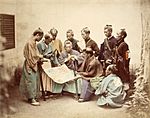Muromachi period facts for kids
 |
|---|
|
Muromachi period (室町時代, Muromachi jidai), also known as the Muromachi era, the Ashikaga era, or the Ashikaga period, is an important time in Japanese history. This period lasted for over 200 years. It began in 1333 and ended in 1573. During this time, Japan was mostly ruled by a powerful military government called the shogunate.
Contents
The Ashikaga Shogunate
The Muromachi period gets its name from the Ashikaga shogunate. A shogun was a military ruler who held real power in Japan, even though an emperor was still the official head of the country. The Ashikaga shoguns had their official home in a district of Kyoto called Muromachi. This special home was also known as the Muromachi Palace (室町殿, Muromachi-dono) or Flower Palace (花の御所, Hana no Gosho). It was the center of their government and power.
Important Events and Timeline
This period saw many important changes and events in Japan. Here are some of the key moments:
- 1333 (Kemmu 1): The Kemmu restoration (建武の新政, Kenmu no shinsei) happened. This was an attempt by the emperor to take back power from the military rulers.
- 1336 (Kemmu 4): Ashikaga Takauji took control of Kyoto. This led to a split in the imperial family. Emperor Go-Daigo set up his court, known as the Southern Court (Nanchō), in Yoshino. Another court, called the Northern Court (Hokuchō), was established in Kyoto.
- 1392 (Meitoku 3 or Genchū 9): The Southern Court finally gave up to Ashikaga Yoshimitsu. This meant that Japan was unified again under one emperor, Emperor Go-Komatsu.
- 1398 (Ōei 5): The famous Kinkaku-ji, also known as the "Gold Pavilion," was built by Ashikaga Yoshimitsu. It's a beautiful temple covered in gold leaf.
- 1467 (Ōnin 1): The Ōnin War began. This was a major civil war that lasted for many years. It weakened the shogun's power and led to a time of great disorder across Japan.
- 1484 (Bunmei 16): The Ginkaku-ji, or "Silver Pavilion," was built by Ashikaga Yoshimasa. This temple is known for its quiet beauty and gardens.
- 1488 (Chōkyō 2): Ryōan-ji was built by Hosokawa Katsumoto. This temple is famous for its simple, yet very deep, rock garden.
- 1543 (Tenbun 12): A Portuguese ship landed at Tanegashima. This was a very important moment because they brought the first guns to Japan. This new technology would change warfare in Japan forever.
- August 15, 1549 (Tenbun 18): A Jesuit Catholic priest named Francis Xavier arrived in Japan. He was one of the first Christian missionaries to come to the country.
- 1555 (Kōji 1): Mōri Motonari won the Battle of Itsukushima (厳島合戦, Itsukushima Kassen), also known as the "Battle of Miyajima." This was an important naval battle.
- June 12, 1560 (Eiroku 3): At the Battle of Okehazama, the forces of Imagawa Yoshimoto were defeated by Oda Nobunaga. Oda Nobunaga would become one of Japan's most powerful leaders.
- 1569 (Eiroku 12): The first Christian church opened in Nagasaki. This showed the growing influence of Christianity in Japan.
- 1570 (Genki 1): At the Battle of Anegawa, the forces of Oda Nobunaga and Tokugawa Ieyasu won an important victory. These two leaders would play a huge role in unifying Japan.
- 1573 (Genki 4): Ashikaga Yoshiaki, the last Muromachi shogun, had to leave Kyoto. This marked the end of the Ashikaga shogunate and the Muromachi period.
Related pages
Images for kids
-
Nanban ships arriving for trade in Japan in the 16th century.
See also
 In Spanish: Período Muromachi para niños
In Spanish: Período Muromachi para niños









